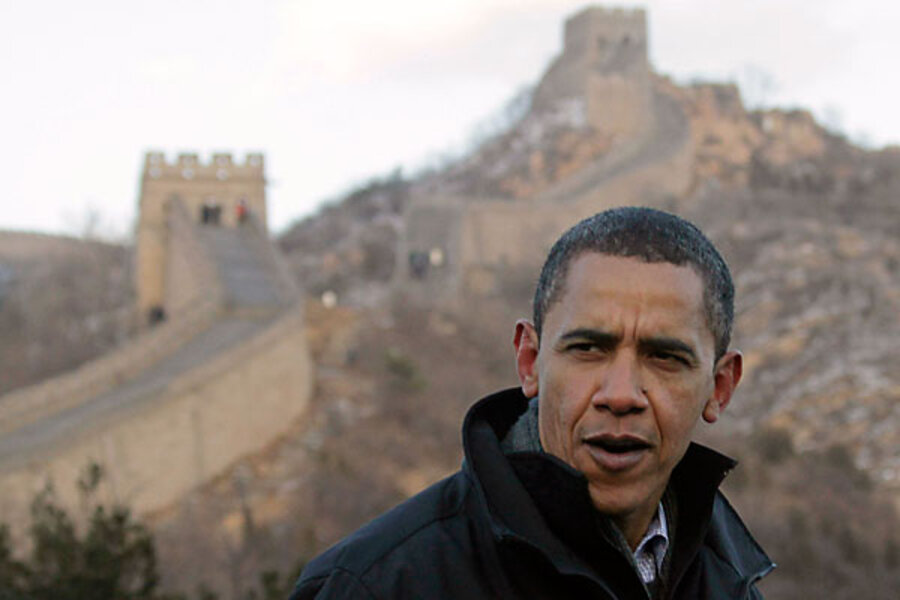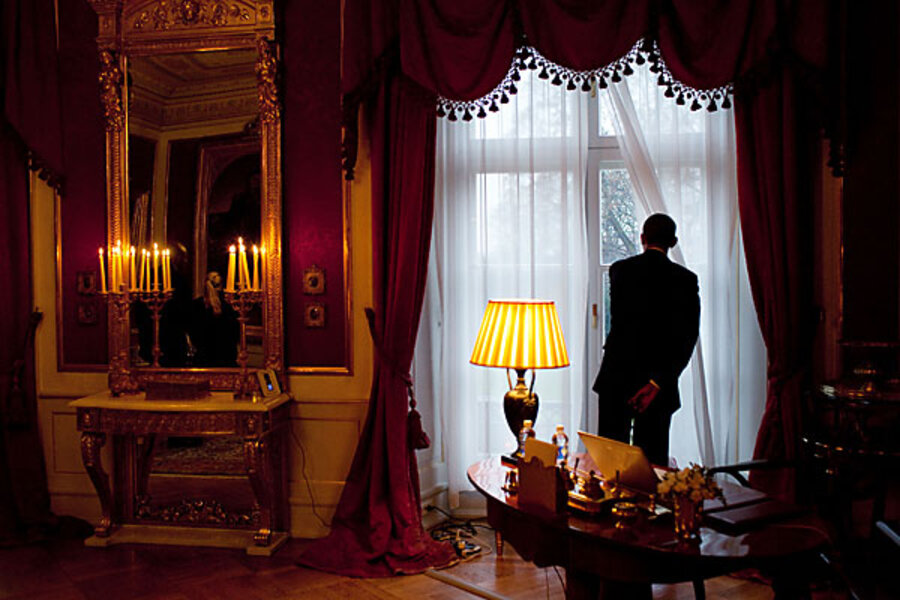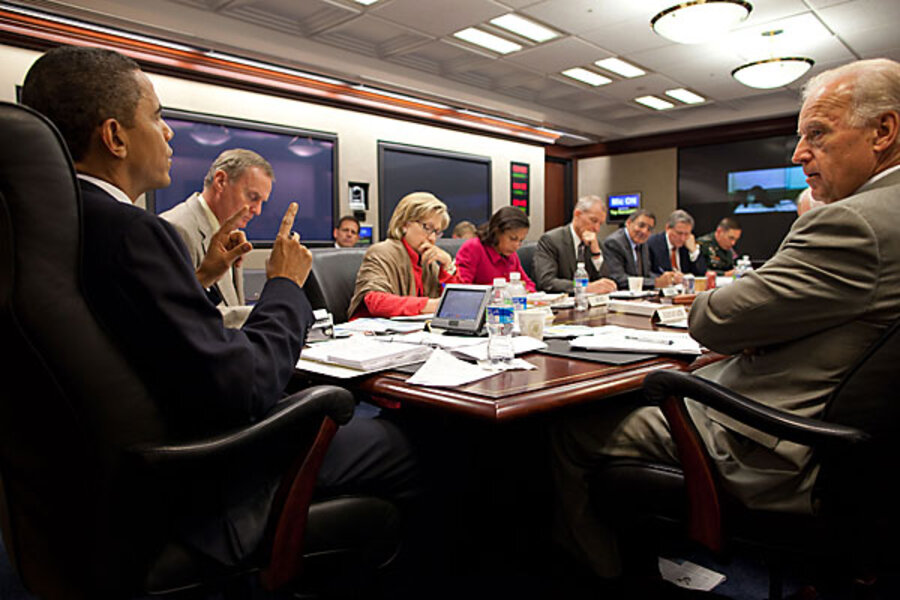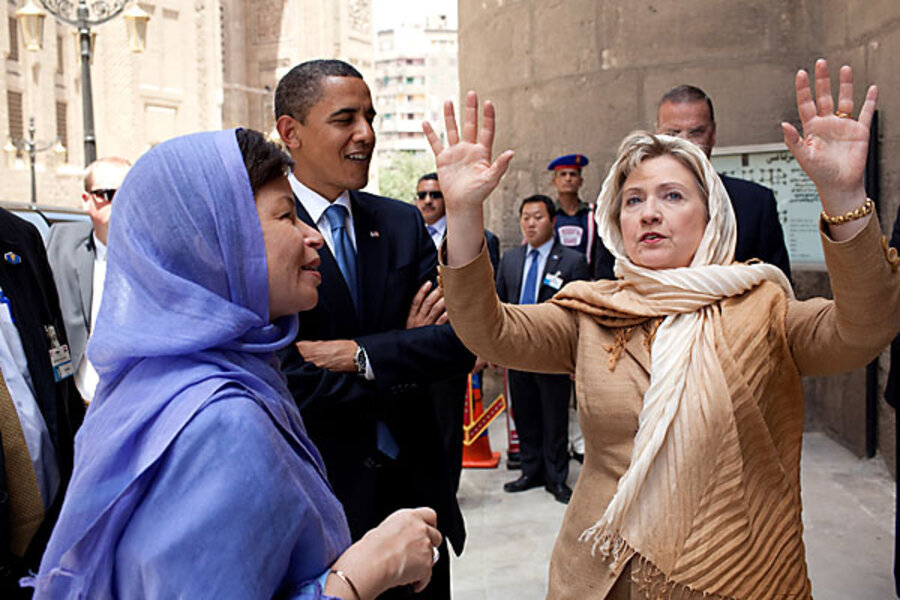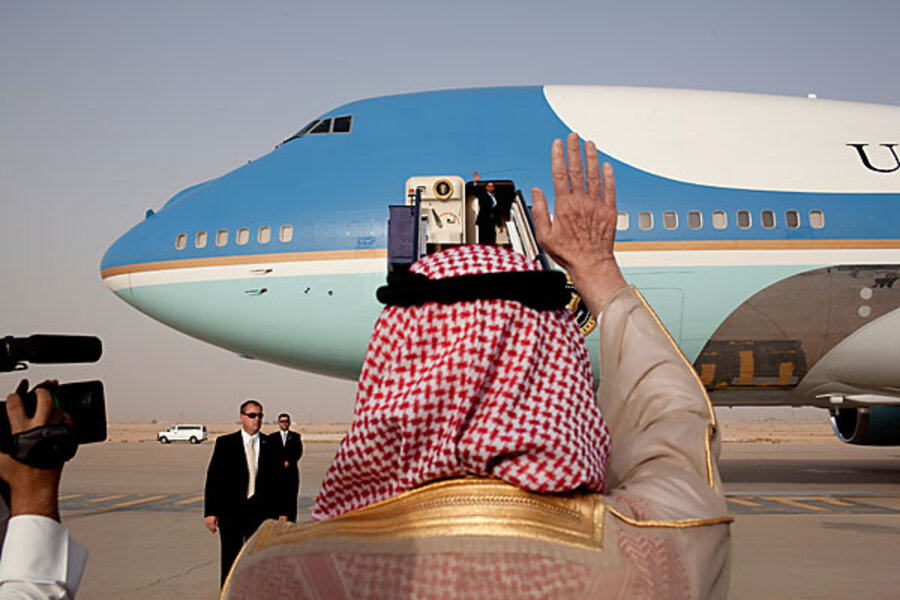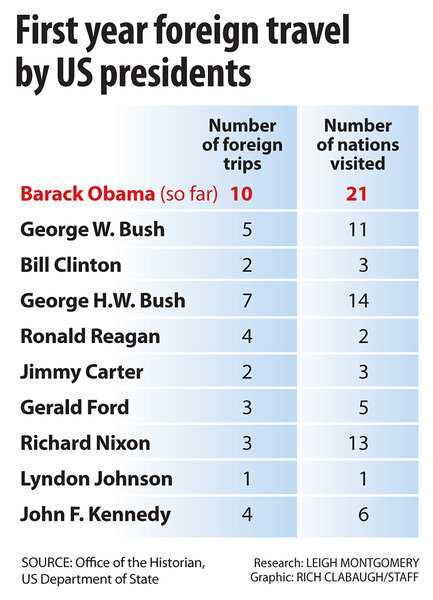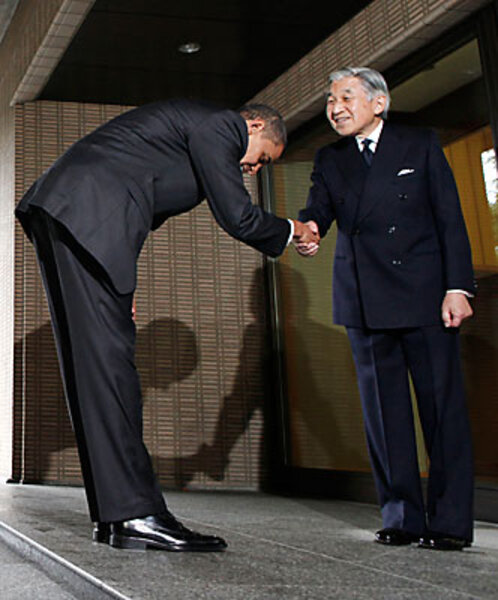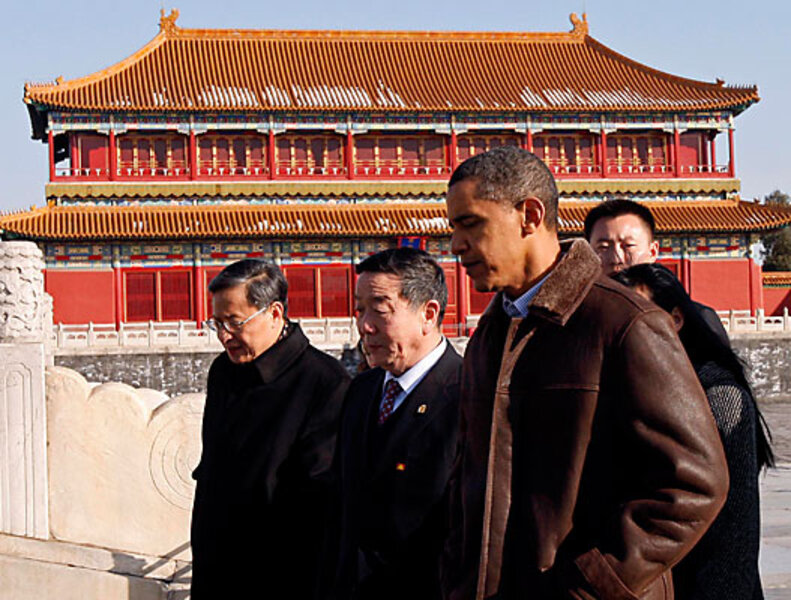Obama at one year: new realism in foreign policy
Loading...
| Washington
The reference was tucked modestly into a list of individuals cited as the world’s true peacemakers at the end of Barack Obama’s surprisingly muscular Nobel Peace Prize acceptance speech. “Somewhere today,” the president said in December, “a young protester awaits the brutality of her government ... [yet she will] still strive for justice.”
The profile in defiant courage he was widely thought to be basing his vision on was Neda Agha Soltan, the young Iranian whose death at the hands of her government during postelection demonstrations in Tehran was captured on video – and became the image viewed round the world.
As shocking as Ms. Soltan’s public killing was, though, even more disturbing for many human rights advocates and supporters of an interventionist American foreign policy was President Obama’s silence on the actions of the Iranian regime itself. True, Obama would end up criticizing Tehran for its repressive response to the protests – eventually. And he has repeated his muted recognition of Iranian dissidence as the protests have continued in 2010.
But his initial tone was that of an idealist who still wanted to achieve a dialogue with Tehran, which represented the top trophy in the president’s vision of conducting diplomacy with America’s adversaries.
One year after taking office, it’s that tension between the reality that has to be addressed and the ideal to strive for that lies at the foundation of Obama’s worldview.
In some ways, it is a surprisingly hawkish vision, in the image of Democrats like Franklin Roosevelt – who fought and won a terrible world war, and then founded the United Nations. But it is also internationalist and multilateralist, like George Bush – the father, not the son – and it is realist like Richard Nixon, who wound down an unpopular war and dared to engage what was then called Red China.
Obama’s is a world of two wars – one of which he has decided to escalate, though (he hopes) for a limited time. It is a world where America will do battle with a violent and stateless adversary not subject to dialogue and negotiation, though in a form that is clipped and less ideological as compared with his predecessor’s.
As his response to the attempted Christmas Day bombing of a Detroit-bound airliner suggests, this is now less a war on terror than a multifaceted national security battle that hinges on intelligence, global cooperation, and police work.
It is a world of regimes lusting for the very nuclear weapons he would eradicate. Obama confronts all this within a reality he sees of an America of finite means and still-unique, though waning, power – and thus an America that will have to rely more on leading by example than by imposition.
“This is a president and foreign-policy team who are very pragmatic, driven by the need to solve problems, and are therefore not out looking for some new template to guide the United States,” says Charles Kupchan, a foreign-policy expert at the Council on Foreign Relations in Washington. “The guiding rule of thumb seems to be, ‘What’s the problem, how do we fix it, and who’s going to help us fix it?’ Questions like regime type and ideology are playing a much smaller role than before.”
Any assessment of Obama's first year in office must deal with the most immediate “before,” which means in this case George W. Bush. His vision for transformation of the Middle East started with “regime change,” to be followed up with an imposed democratization.
While President Bush’s decisionmaking often derived from ideological certitudes and presidential gut feelings, Obama’s is seen as deliberative – some say hyperdeliberative – as exemplified by the 10 national-security team meetings he held over nearly three months before he made his Afghanistan decision.
Obama’s decision to send 30,000 additional troops to Afghanistan, announced Dec. 1 at West Point before a sea of cadets in dress gray, is one of a few major initiatives that experts have pored over to glean the signposts of this president’s foreign policy. Others include his engagement strategy with adversaries, in particular Iran, and what was widely interpreted as a deferential demeanor during his trip to Asia – most notably toward Beijing.
Like Mr. Kupchan, many analysts are hesitant to proclaim an “Obama doctrine” that would define this president the way preventive war and American unilateralism made up the Bush doctrine. Engagement of America’s adversaries is the shorthand some experts have settled on to describe an Obama doctrine. For others, it’s a whittling down of global aspirations to a core of realistic goals.
But as Obama enters his second year in office, the elements of a defining approach to foreign policy continue to emerge. They include a realistic assessment of available resources when making new commitments, recognition of an accelerating shift in the distribution of global power – most notably in favor of Asia – and a correlative recognition of the limits of American power.
Acknowledgment of those limits has led in turn to a revaluation of the role of other countries in addressing global issues – and Obama priorities – from global warming to nuclear proliferation.
The president’s Afghanistan strategy, with a more limited view of the global war on terrorism, stands out to many analysts as offering some of the best insight into Obama’s foreign-policy vision.
“His approach to international affairs comes out of a more narrowly construed definition of American national interests,” says Richard Fontaine, a senior fellow at the Center for a New American Security, a Washington think tank. “In his Afghanistan speech, he narrowed the scope of the mission to defeating Al Qaeda, and I don’t think he uttered the word democracy once.”
He also cites the setting of a date to begin withdrawal and “the president’s focus on a mission commensurate with our resources” as other examples of the president limiting the scope of what he intends to accomplish there. Still Mr. Fontaine, who was Republican presidential candidate John McCain’s chief foreign-policy adviser, speaks of Afghanistan and Iran as “inherited wars” – so perhaps not the best place to look for an Obama blueprint.
But he sees the same “narrowing” of goals elsewhere in the president’s diplomacy.
“Look at the trip to China, where human rights took a back seat and the agenda suddenly looked less full than with Bush,” he says. “It’s another example of narrowly concentrating with steely-eyed focus on core national interests.”
Others counter that Obama’s foreign-policy approach is not so much about narrowing goals as it is about redefining American power for the 21st century.
“In some ways, we have moved back under Obama to a more traditional American internationalism of the kind practiced by George H.W. Bush,” says Heather Hurlburt, a former speechwriter to President Clinton and Madeleine Albright, who is now executive director of the National Security Network in Washington. “But there is also a 21st-century difference that accounts for so much of what [Obama] is doing.” That “difference” includes a diffusion of global power among a longer list of players – countries like China, India, and Brazil.
But it also derives from what Ms. Hurlburt calls a “sense of eight years of squandering our military power and our smart power, and then an economic crisis that has placed additional limits on us.” The result, she says, is that “Obama has to take this diffusion of power into account even as he acts to
repair the damage done to America’s standing and ability to persuade in the world.”
Comparisons of Obama’s foreign policy to that of the elder Bush’s have mushroomed. This is especially true after the president announced an Afghanistan policy with limited and specific objectives (reminiscent of a Gulf War that stopped short of taking out Saddam Hussein) and built around a substantial international effort.
But it is Obama himself who first invited the comparisons with his stated admiration for the former president’s “wise” handling of the disintegration of the Soviet Union and the Gulf War.
“The truth is that my foreign policy is actually a return to the traditional bipartisan realistic policy of George Bush’s father, of John F. Kennedy, of, in some ways, Ronald Reagan,” candidate Obama declared in Pennsylvania before winning the Democratic nomination.
Obama, of course, was never a diplomat as the first Bush was, whose résumé included a stint as the US ambassador to the United Nations.
But Obama’s extraordinary string of speeches in foreign capitals in his first year – in Prague, Czech Republic; Moscow; Ankara, Turkey; Cairo; and Accra, Ghana; all topped off by his “just war” speech in Oslo – suggests a diplomat’s understanding of the unique influence of the American president, especially a globally popular one. The speeches also announced that a more cooperative America was back.
“What stands out is the way this president has changed the image of America in all our countries,” says a senior European diplomat in Washington. “We see it in Afghanistan. We see it in his speeches like the one to the world’s Muslims from Cairo. It’s a strong America, but one that knows that no one country has the solutions to the world’s problems.”
Obama’s decision to stick to an extended trip to Asia in November, even as critical domestic issues, including healthcare reform and job creation, demanded attention, underscored the administration’s focus on a region that will increasingly determine the course of global affairs. It also suggested, given that the trip promised no breakthroughs, an approach emphasizing patient and sustained diplomacy with the hope of delivering results down the road.
(Obama was criticized by conservatives for being too accommodating in Asia, symbolized by the president’s deep bow and handshake to Japanese Emperor Akihito in Tokyo. The New Yorker magazine subsequently had great fun with the “wow bow,” depicting on its Dec. 14 cover Obama bowing to and shaking the velvety glove of a jolly red-suited fellow who has just come down the Oval Office chimney.)
In the end, Obama might be free to patiently test the validity of a return to a “traditional” American foreign policy in the 21st century and to juggle competing demands of realist and idealist approaches were it not for one thing: the war in Afghanistan and his decision to escalate it.
“Wars consume presidencies,” says Bruce Riedel, a former CIA official who led Obama’s first interagency Afghanistan review in the initial weeks of his presidency. Estimating that Obama has 18 to 24 months to show results in what is now “his war,” Mr. Riedel, now at Washington’s Brookings Institution, says Obama “is going to have to come out once a week, maybe more often than that, explaining why we’re there, what we’re doing, whether it’s succeeding.”
Others are even more unequivocal about how Afghanistan has defined – and boxed in – Obama’s foreign policy.
“Afghanistan offered Obama the opportunity to articulate a distinctive approach and he muffed it – by his decision to add more troops he’s essentially endorsed the long war,” says Andrew Bacevich, a former Army colonel and Vietnam veteran who teaches international relations at Boston University. Mr. Bacevich, who lost a son in the Iraq war, says he sees strains of “traditional American internationalism” in Obama’s foreign policy, including the idea that “America should lead the world, but that it does so most effectively when it adheres to a collaborative approach and to the international norms it helped create.”
But he says those impulses won’t matter now, because Obama “has decided to fight violent anti-Western jihadism with more war, giving more US troops the task of bringing significant change to an Islamic country.” And what flows from that decision, he concludes, “now becomes the focal point of his foreign policy.”
It’s a harsh assessment that stands as a kind of warning to Obama. Indeed, some foreign-policy experts say Obama’s long deliberation and preoccupation with “getting the Afghanistan decision right” suggests a president well aware of the war’s potential for becoming his quagmire. Obama “wanted a formulation that allows a measure of stability without Afghanistan becoming a bottomless pit that jeopardizes his presidency,” Kupchan of the Council on Foreign Relations says. “That’s why he kept going back to the drawing board.”
Other issues, including Iran and Obama’s goal of reaching a world of zero nuclear weapons, may turn out to be better measures of this president’s attempts to balance a realist foreign policy with aspirational goals. Kupchan, for one, says Iran should not define Obama’s foreign policy any more than Afghanistan.
But he says Iran has allowed Obama to apply an approach that says “pragmatism and outreach and a focusing on solving problems can lead to new levels of global cooperation.”
Ultimately, that cooperation may not include Iran. Indeed, the window of outreach to Tehran appears to be closing, with Obama speaking more frequently of applying new international sanctions to deter it from building a bomb. Yet if the outreach to the toughest cases like Iran “means greater cooperation on this and other issues from the Chinas and Russias of the world,” as Kupchan says, that could end up an even bigger prize.
Throughout history, only a handful of US presidents have proved to be transformational in foreign affairs. Obama may not be one of them, in part because of the challenges facing America today. But if he can navigate the Afghanistan quagmire, he might still be the 21st century’s Richard Nixon in foreign policy, with a little Woodrow Wilson thrown in.
He could reimagine America’s relations with new global powers, guided by modest hopes for forging a better world.
Call it realist idealism. ρ



